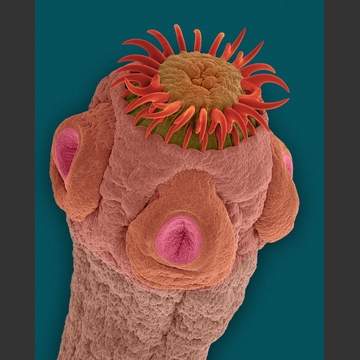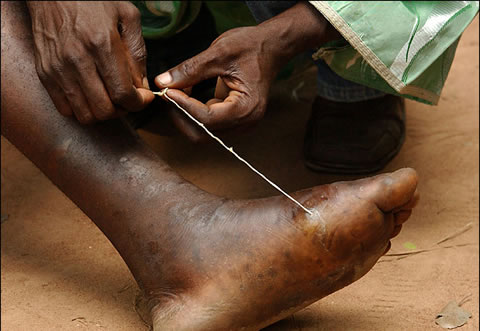Medical Parasitology
Integrative Biology 116, University of California at Berkeley, Summer 2010


Judy Sakanari, Ph.D.
IB 116/L
Medical Parasitology
May 24 - July 2, 2010
Lecture:
Room 122, Wheeler Hall
9:00 a.m. - 12:00 p.m.
Tuesdays and Thursdays
Lab:
Room 3019, VLSB
1:00 p.m. - 4:00 p.m.
Tuesdays and Thursdays
OR
9:00 a.m. - 12:00 p.m.
Wednesdays and Fridays
Enrolled Students: Log-in at bSpace.berkeley.edu for course resources
Photos
Above: Dr. Sakanari in her lab.
Below: Removal of a Guinea worm.
Right: Mammalian tape worm. Beautiful photo by Dr. Dennis Kunkel. Copyright Dennis Kunkel Microscopy, Inc.

IB 116 Medical Parasitology (4 units)

Course Instructor:
Judy Sakanari, Ph.D.
Sandler Center for Basic Research in Parasitic Diseases
UCSF, Mission Bay Campus, Byers Hall QB3 Rm 508A
San Francisco, CA 94158-2330
EM: jsakanari@cmp.ucsf.edu
A. Course Description
This course has two-3 hr lectures and two-3 hr laboratories per week. We will discuss the biology, ecology, evolution, epidemiology, pathogenesis, diagnosis and prevention of a variety of parasitic diseases that infect humans. You will learn about the host-parasite relationship in the context of how social, economic and ecological and evolutionary factors contribute to the host-parasite relationship. Laboratory exercises involve microscopic identification of prepared slides and specimens obtained from fresh material. Participation on a field trip (to UC San Francisco) is required. The prerequisite for this course is Biology 1A and 1B; knowledge in physiology and anatomy is recommended.
B. Integrative Biology and Plant & Microbial Biology Majors
This course fulfills one of several requirements for students majoring in Integrative Biology or Plant & Microbial Biology. Please consult your respective departmental advisors for details.
C. Goals and Objectives
1. You will learn about the most important parasitic diseases affecting humans including
• Names of parasitic helminths (worms) and protozoa, their vectors and intermediate and reservoir hosts.
• Parasite life cycles, the diagnostically important stages and the biological aspects of the host-parasite relationship.
• Epidemiology of the diseases, with special reference to transmission to humans; pathogenesis of the diseases, emphasizing how infections in specific tissues/organs are associated with specific symptoms; treatment, differential diagnosis, and management of the diseases.
2. You will learn to recognize patterns related to the infectious disease process including:
• The impact of parasitic diseases in the context of world health; prevalence and geographical distribution of infection/disease.
• The role of the immune response in moderating or exacerbating the disease.
• The interplay of social, economical, and ecological factors that contribute to parasitic infection and disease.
3. You will develop an understanding of major concepts relevant to parasitic diseases
including:
• Discerning the difference between parasitic infection and disease.
• The development of drugs and vaccines against parasitic infections.
• The roles vectors and reservoir hosts play in the persistence of infection.
• Parasitic infections as emerging infectious diseases.
D. Laboratory
The laboratory material is meant to complement the information discussed during lecture. The labs will include demonstration slides, living material, videos and other illustrative material. Students are expected to examine specimens in detail using microscopes at their desks and using reference material. The laboratory also includes a mandatory field trip. Last year we visited the UCSF Clinical Laboratory at China Basin and a research lab at the Mission Bay campus of UCSF.
E. Textbook
The textbooks, entitled Parasitic Diseases by Dickson D. Despommier, Robert W. Gwadz, Peter J., Ph.D. Hotez (Apple Trees Productions, 5th Edition ISBN 0-9700027-7-7) OR Foundations of Parasitology by Larry S. Roberts and John Janovy, Jr., are meant to supplement the lectures and the lab.
The Parasitic Diseases textbook has excellent illustrations of the life cycles and provides concise descriptions of the clinical symptoms for each infection. This book is recommended for students entering the medical and health science fields.
The Foundations of Parasitology textbook is more comprehensive, provides the reader with a historical background, interesting parasite stories, and covers many groups of parasites that infect humans and animals. This book also includes chapters on the biochemistry of parasites and immune response to parasites. This book is recommended for students entering the field of veterinary and animal sciences.
F. Other Resources: Color Atlas of Parasites
The 6th edition of the Color Atlas of Parasites includes 113 plates of parasites and their vectors, containing 600 individual photographs, all but 6 in color. The book is spiral bound and covered with a sheet of clear 10-mil plastic. Printed at 1200 dpi on a Xerox Phaser solid ink printer, the images clearly show diagnostic features important for parasite identification. A brief explanatory text accompanies each plate on the facing page, emphasizing major characteristics of the parasite's structure, life cycle, and medical significance. For more information, send e-mail to: sullivan@usfca.edu or go to http://www.geocities.com/parasiteatlas/parasites.html. Individual copies cost $38.00 (not including shipping & handling). Allow 2 weeks for delivery. Many students found having a hardcopy of this atlas helpful.